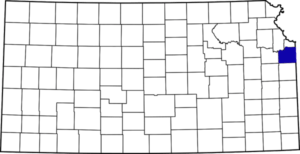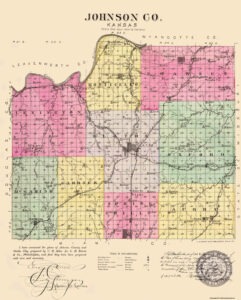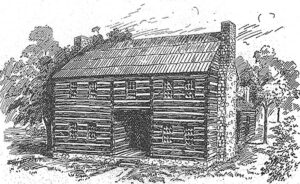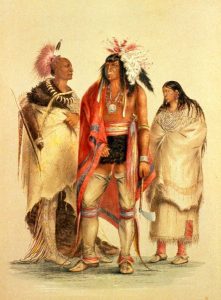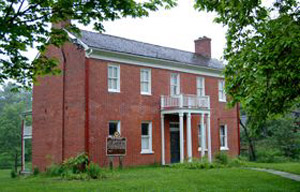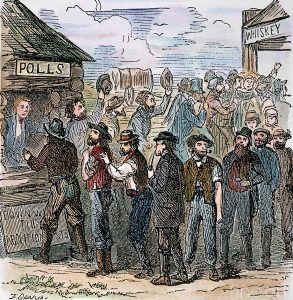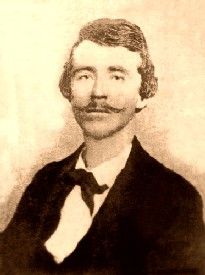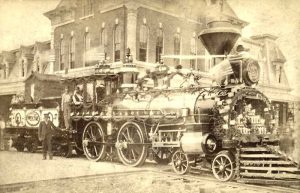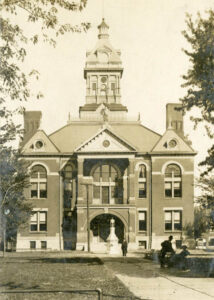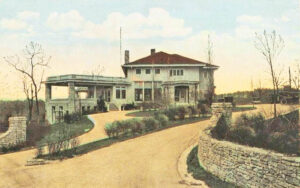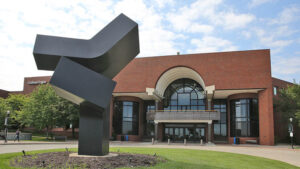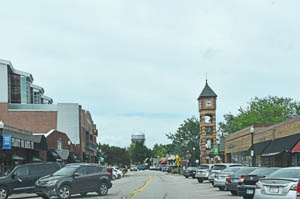Towns:
De Soto
Edgerton
Fairway
Gardner
Lenexa
Leawood
Merriam
Mission
Mission Hills
Mission Woods
Overland Park
Olathe – County Seat
Prairie Village
Roeland Park
Shawnee
Spring Hill
Stilwell – Unincorporated
Westwood
Westwood Hills
Johnson County Border Troubles
Quantrill Raids Olathe – September 1862
One-Room, Country, & Historic Schools of Johnson County
Santa Fe Trail in Johnson County
Shawnee Methodist Mission – On the Santa Fe Trail
Blue River
Brush Creek
Cedar Lake
Kansas River
Gardner Lake
Heritage Lake
Hillsdale Lake
Lake Lenexa
Lake Olathe
South Lake Park
Shawnee Mission Lake
Spring Hill City Lake
Johnson County, Kansas, located in the northeast portion of the state, is the most populous county in Kansas. Its county seat is Olathe. As of the 2020 census, the population was 609,863. The county is mainly suburban and contains several Kansas City, Missouri, suburbs, including Overland Park, the second-most populous city in the Kansas City Metropolitan Area.
Johnson County was once part of the large territory of the Osage Indians. After the Indian Removal Act of 1930, the United States government reserved much of the area for a reservation for the Shawnee Indians, who were relocated from east of the Mississippi River.
The first white hunter to come to Kansas is believed to have been Jacob Pursley, who, in 1802, crossed the eastern part of Kansas, making his way to New Mexico.
Other adventurous men followed, and soon trade was established between Santa Fe, New Mexico, and Booneville, Missouri, the frontier town of the West. Over the years, Independence, Missouri, secured the trade and became the starting point for westward-bound expeditions on the Santa Fe Trail. The trade grew so much that in 1825, the Government employed Major George Sibley to establish a wagon road from the Missouri line to Santa Fe, New Mexico. This road ran through Johnson County from Little Santa Fe, Missouri, to about four miles south of Olathe.
In 1829, Reverend Thomas Johnson, a Methodist Episcopal missionary, went to the Shawnee country to establish an Indian mission and a school. The Shawnee Mission school >was located about six miles west of Westport, Missouri, and about one mile from the Missouri line. A carpenter shop, a blacksmith shop, a shoemaker’s shop, a steam grist mill, and a sawmill connected with the mission.
One of the most critical events in early county history was the founding of the Shawnee Methodist Mission and the Indian Manual Labor School in 1839. Besides the Mission, the first church was established in Shawnee in 1840 and was known as the “Old Log Church.” The first county fair was held in the Edgerton/Gardner area, and the first school districts were formed at the same time.
The territory was opened to white settlement with the passing of the Kansas-Nebraska Act of 1854. At that time, the area was crisscrossed by several major westward migration routes, including the Fort Leavenworth Military Road, the Santa Fe Trail, and the Oregon–California Trail.
From the beginning, Johnson County was the scene of many conflicts between the Free State and pro-slavery parties. During this time, numerous abolitionists and pro-slavery proponents rushed to Kansas to determine whether it would be a free or slave state. As the controversy waxed more intense, the conflicts became more violent. Early elections held were fraudulent and were, for the most part, managed by pro-slavery men. The continuous interference of Missouri border ruffians in Kansas affairs on the eastern tier of counties aroused great animosity among the free-state men, resulting in the border war, also known as Bleeding Kansas.
The first election held in the territory was in the fall of 1853, before the county was organized. At this election, Reverend Thomas Johnson of the Shawnee Mission was elected delegate to Congress to urge the territory’s organization. However, because he was chosen without the authority of the law, he was not admitted to a seat as a delegate.
At the election of March 20, 1855, for members of the territorial legislature, Reverend Thomas Johnson was elected to the council and made its president. One of the legislature’s first acts was the organization of settled portions of the territory into counties. Isaac Parish was appointed county sheriff, and William Fisher, Jr., probate judge. At this session, the Santa Fe Trail through the center of the county was declared a territorial road.
Comprised of 476 square miles, the county was created on August 25, 1855, by the Kansas Territorial Legislature. One of the first 33 counties in the state, it was named for the Reverend Thomas Johnson, who had served as a missionary to the Shawnee Indians and was a member of the territorial legislature.
A battle growing out of politics called “the first battle of Bull Run,” because it was fought on Bull Creek, occurred on September 1, 1856. When James Lane, commander of the free-state men, met the pro-slavery forces of John Reid, a few shots were exchanged, and Reid retreated into Missouri. No blood was shed.
The county was not officially organized until September 17, 1857. Several communities were already established by then, including Olathe, Spring Hill, Gardner, De Soto, Shawnee, Edgerton, Leawood, Lenexa, Merriam, Mission, Mission Hills, Overland Park, Prairie Village, Westwood, and Westwood Hills. By that time, several schools had been established.
The first county seat was established in Shawnee. However, in October 1858, an election was held, and the county seat was changed to Olathe. Johnson County initially used space on the second floor of the Harry Case Building as the county courthouse.
An interesting public figure in the county was James Butler Hickok, who was a constable in Monticello Township in 1858 before becoming famous as a scout and frontiersman. W. B. Strang, the owner of the Strand Line, built the first self-propelled railroad motor car in the world.
The first newspaper published was the Olathe Herald, whose first issue appeared on August 29, 1859.
During the Civil War, Johnson County furnished its full share of soldiers. About three weeks after the first call for troops, a company of 50 men enlisted and organized, with S. F. Hill as captain. Another 500 men were enrolled in the Thirteenth regiment, of which Thomas M. Bowen was commissioned as a colonel. Several other infantry companies were formed in 1862, working at Forts Leavenworth, Riley, and Larned.
On September 6, 1862, William Quantrill raided Olathe, which was in a defenseless condition. With a band of about 140 men, he entered the town, invaded and plundered houses and stores, and corralled the citizens in the public square. The guerrillas then raided Spring Hill, where Philip Wiggins and Josiah Skinner were killed to protect property. In the raid, they killed about six men and destroyed numerous homes and businesses.
After the Lawrence Massacre in 1863, the Fifteenth Regiment of Cavalry was raised. Johnson County furnished one entire company. This regiment distinguished itself in 1864, fighting General Sterling Price’s army on its notorious raid.
On November 7, 1865, an election was held to issue $100,000 in bonds to the Kansas City & Neosho Valley Railroad, which passed. The railroad began to be built in the summer of 1867 and was completed to Olathe in November, and the county’s south line in 1869.
Along with those who came to Kansas as settlers were several speculators who examined the Indian treaties and found the Indians could sell and convey a valid title to any person who complied with the rules of the government’s Interior Department for the sale of Indian lands. The first sales of such lands to speculators began in October 1867 to Blunt, Irvin & Co. However, in December 1867, the government made it impossible for the Indians to sell their property.
In April 1869, another election was held on issuing $100,000 in bonds for two railroads — the St. Louis, Lawrence, and Denver, and the Kansas City & Santa Fe. The bonds were passed. The Kansas City & Santa Fe Railroad was completed to Ottawa in 1870, and the St. Louis, Lawrence & Denver was built from Lawrence to Pleasant Hill in 1871.
By 1870, the county had a population of 13,000. The population remained relatively stable, and the area remained predominantly rural and agriculturally based until the early 20th century.
County voters approved a special tax to build the first official county courthouse for $36,414. The three-story brick building opened in 1892.
Transportation played a key role in the county’s suburban development when two interurban rail lines helped to accelerate the growth. In 1904, W.B. Strang began the construction of an electric railroad that passed through his newly platted community of Overland Park, the established town of Lenexa, and ended at the county seat of Olathe. A second interurban railroad, the Hocker Grove Line, was constructed through Merriam and Shawnee. The Hocker Grove and Strang Companies served as real estate development ventures, with their owners platting new subdivisions along their lines.
In 1907, there were 95 organized school districts and a school population of 5,428.
In 1910, a line from Holliday ran southwest through Olathe into Franklin County; a line of the St. Louis-San Francisco Railway entered the extreme northeast, crossing southwest to Olathe, then south into Miami County; another line of the same road crossed from the eastern border to Olathe. The Missouri-Kansas-Texas Railroad operated its trains from Kansas City over the tracks of the St. Louis & San Francisco through the county, and a line of the Missouri Pacific Railroad crossed the southeastern corner. At that time, the county had 93.75 miles of railroad tracks.
During the 1910s, early suburban developments began popping up in northeast Johnson County. With its close proximity to the newly industrialized Kansas City, Missouri, innovative community developers – such as William B. Strang and J.C. Nichols – saw new potential. More and more families were lured from established Kansas City neighborhoods into these new suburban developments.
In 1914, developer J. C. Nichols spurred the boom when he built the Mission Hills Country Club to lure upscale residents who previously had been reluctant to move from Missouri to Kansas. Suburban development continued steadily until the close of World War II.
Between 1910 and 1940, the county’s population grew from 18,288 to 33,327. Most of this growth was in northeast Johnson County, along busy roads and the electric railroads. The rural, agricultural communities in the western and southern parts of the county remained the same as they were in the 19th century.
Significant change began when the United States entered World War II. Two major facilities were constructed in the 1940s, including the Olathe Naval Air Station, which trained pilots and served as a supply center. It was opened in 1942 on 640 acres south of Olathe. The Sunflower Ordnance Works opened the same year on roughly 10,000 acres south of De Soto. The mammoth plant drew workers from a 100-mile radius and laborers from 18 states. At its height in 1945, over 12,000 employees worked 24 hours a day making rocket fuel.
In the decades following World War II, the county’s population experienced a significant surge. By 1950, the number of county residents increased to 63,000.
In 1951, construction began on a new $985,000 courthouse to meet the needs of Johnson County’s growing suburban population. Johnson County’s second courthouse was dedicated in October 1952. The same year, the 1892 courthouse was demolished due to safety concerns.
In the 1960s, the county’s population doubled again to 120,000. The most significant growth continued to be in the northeast section of the county, especially in Prairie Village, Overland Park, Shawnee, Merriam, Roeland Park, Mission, and Leawood.
Along with the boom in residents came commercial and industrial growth, including shopping centers, gas stations, warehouses, and office parks. By 1965, 135 companies with nearly 4,000 employees were conducting business in the county, and there were 102 manufacturing companies.
The county’s first indoor shopping center, Metcalf South, broke ground in 1967 at 95th and Metcalf. By the mid-1970s, less than one-third of suburban residents drove to a central city, or “downtown,” regularly.
Johnson County’s status as the metropolitan leader in office development began with the developments along College Boulevard in Overland Park. Johnson County Community College was the first to move to the corridor when its new campus opened in 1972. At the time, nearly 100 full-time faculty members were teaching 3,600 students, providing new opportunities for post-secondary education. In 1973, Black and Veatch moved its corporate headquarters to 115th, and the Lamar and the Corporate Woods office park was established in 1975.
From 1970 to 1984, the number of people employed by businesses within the county increased by more than 200%. Once a bedroom community to Kansas City, Missouri, Johnson County soon employed more than half its working residents in the area.
By 2005, the county’s population reached 510,000. By 2020, it was 609,863, making it the most populous county in Kansas.
Despite expansions to the second Johnson County Courthouse, the structure was deemed inadequate for the county’s population, and the 1952 courthouse was closed in 2020 and then demolished. In the meantime, a new courthouse began to be built, which opened in January 2021.
Interesting sites in the county include the Mahaffie Stagecoach Stop, Ensor Historic Site and Museum, Lanesfield School, Legler Barn, Old Shawnee Town, Shawnee Methodist Mission, the Chris Fangro Building, and the Strang Line Barn.
©Kathy Alexander/Legends of Kansas, updated September 2025.
Also See:
Sources:
Blackmar, Frank W.; Kansas: A Cyclopedia of State History, Vol I; Standard Publishing Company, Chicago, IL, 1912.
Blair, Ed; History of Johnson County, Stand Publishing Company, Lawrence, KS, 1915.
Cutler, William G; History of Kansas; A. T. Andreas, Chicago, IL, 1883.
Johnson County, Kansas
Johnson County History
Kansapedia
Shawnee Mission Post
Steed, Laura; Ghost Towns of Johnson County, 1973, unknown publisher.
Wikipedia


